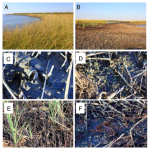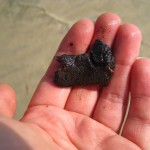The title speaks for itself, but damn, look at these figures! Last week in PLoS ONE, cool kids Montagna et al. (2013) showed some rather dramatic results from environmental monitoring focused on deep-sea mud, conducted in the Gulf of Mexico after BP’s 2010 blowout bonanza. These samples were gathered in September-October 2010, only two months after oil stopped flowing from the Deepwater Horizon wellhead.
The authors used chemical analysis to look for signatures of DWH oil, while simultaneously counting and identifying species of meiofauna (microscopic animals such as nematode worms, copepod crustaceans, etc.) and macrofauna (slightly larger, but still small animals such as polychaete worms). In this way, the presence of oil compounds could be compared with the number of deep-sea species present and the abundance of different organisms.
Aaaand, there’s no questioning these results. Here’s a map of sample sites, where color indicates impact (red = highest impact, with a high chemical signature of oil, low species diversity, and high nematode:copepod ratios, which is a biological indicator of oil pollution):

Now we zoom in and focus on the area surrounding the wellhead:
Since you can’t sample everywhere in the deep-sea, the authors also used their dataset to model the predicted benthic footprint over a wider area. Remember, red is bad:
And again, zooming into the area directly around the wellhead. Shazaam:
In addition to confirming the impact around the wellhead, this modeling approach picks up on shallow water impacts (orange patches off Louisiana, likely driven by surface transport of oil slicks), as well as a predicted area of moderate impact extending 17km to the southwest of the wellhead (remember that deepwater oil plume? Yeah, it seems to have affected animals living in the mud below it).
Note that the red “severely impacted” deep-sea area is 24.4 square kilometers, and the moderately impacted yellow area is 148 sq km (in total, that’s more than TWO Manhattans impacted by oil. Imagine New York City covered in sticky crude twice over…).
When you think about the size of the deep-sea impact, the road to recovery also seems quite grim. We’re talking possibly decades to return to business as normal:
Full recovery at impacted stations will require degradation or burial of DWH-derived contaminants in combination with naturally slow successional processes….Recovery of soft-bottom benthos after previous shallow-water oil spills has been documented to take years to decades [39,40]. In the deep-sea, temperature is uniformly around 4°C, and TOC [total organic carbon] and nutrient concentrations are low, so it is likely that [oil] hydrocarbons in sediments will degrade more slowly than in the water column or at the surface. Also, metabolic rates of benthos in the deep-sea are very slow and turnover times are very long [41,42]. Given deep- sea conditions, it is possible that recovery of deep-sea soft-bottom habitat and the associated communities in the vicinity of the DWH blowout will take decades or longer.
Reference:
Montagna PA, Baguley JG, Cooksey C, Hartwell I, Hyde LJ, Hyland JL, et al. (2013) Deep-Sea Benthic Footprint of the Deepwater Horizon Blowout. PLoS ONE, 8(8):e70540.








